|
|
|
Rear of Westfield Acres - 1995 |
WESTFIELD ACRES
From Start to Finish 1938-2001
|
|
|
Rear of Westfield Acres - 1995 |
|
Welcome to the un-official Westfield Acres Web Page. Here you will find a web-page dedicated to the history of Westfield Acres, the times in which it was first built, and images and text covering life at the Acres since the first families moved there on May 1, 1938 until it was finally demolished in 2001. If you have any stories or images you would like to share about life at Westfield Acres over the last 60+ years, please comment at the bottom of the page. Phil Cohen |

|
The first manager and assistant manager at Westfield Acres were Meyer Wessel and Mary Ellen Soistmann. I don't think enough credit can be given these two individuals in successfully implementing the then basically untried proposition of publicly operated low-income housing. While others deserve much credit for building it, Wessel and Soistmann, who became manager herself around 1943, ran it , and during their tenure ran it well. |
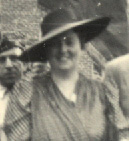
|
| Camden Courier-Post - FEBRUARY 14, 1936 |
|
VON
NIEDA OPPOSES NEW CITY SCHOOL Objection to the city burdening itself with any more school expenses, was voiced yesterday by Mayor Frederick von Nieda at a meeting of the Mayor's Housing Committee. The mayor's viewpoint was made clear to members of the committee who met in his office to map out a plan to be submitted to Washington which would make possible a 100 percent grant by the government for the proposed school to be erected at the .$3,000,000 "Westfield Acres" housing project. The mayor declared his objection to any additional school burden after it was brought out that the office of W.P.A. Administrator Harold L. Ickes had notified the committee the city's proposal for a 30-room school has been held up because there are no available government funds. "I am opposed to any additional school expense on the city because of this project," Mayor von Nieda said. "If the housing project is to come here, the government must meet its share. "We want another school and not a shack. There is already a temporary school on Thirty-second street between Hayes and River avenues, and we don't want any more of that. I am against any more spending so far as the city is concerned. The board of education has all it can stand. There will be no more spending, only over my dead body." Following the mayor's statement, James W. Burnison, chairman of the committee, named a subcommittee to confer with the board of education and other local educational officials in an effort to map out some plan acceptable to Washington. The sub-committee consists of A. J. Rosenfeld, Charles F. Hollopeter and Joseph N. Hettel. Mayor von Nieda told the group that a 30-room school would cost at least $250,000, and that approximately 400 families would be housed at the development, with at least one child to every family. Burnison urged passage of federal legislation which would give the city definite assurance that it would be paid all service charges, such as sewer and water, in lieu of taxes. A dedication committee was named to arrange for exercises at such time as the project gets under way. The committee includes George V. Walsh, project manager, Hollopeter and burnison. Other members of the housing committee are James V. Moran, Joseph Mitton and Rosenfeld. |
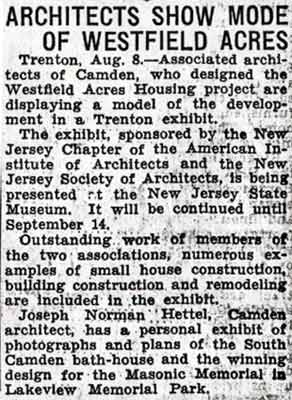
|
Camden Courier-Post August 10, 1936 |
| Camden Courier-Post - August 12, 1936 | |
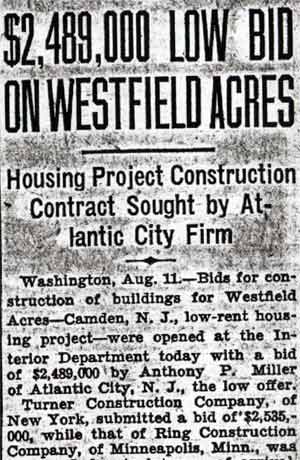
|
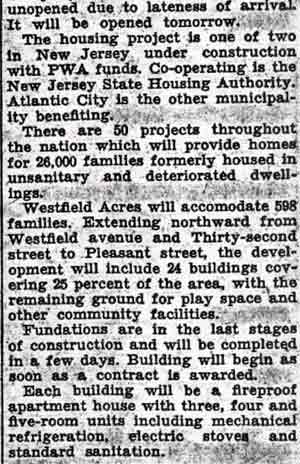
|
| Camden Courier-Post - October 12, 1936 | ||
| Safeguards Against Home Accidents Ordered for Westfield Acres | ||
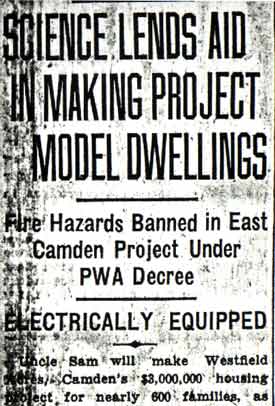
|
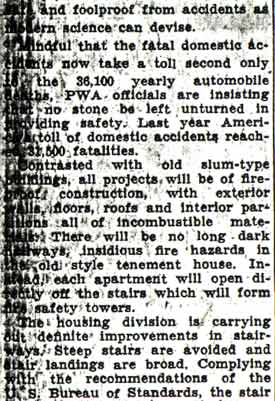
|
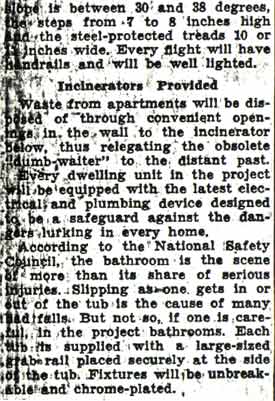
|
| …continued… | ||
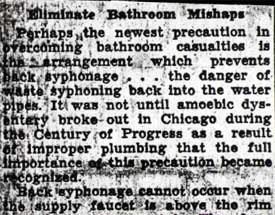
|
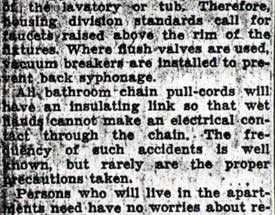
|

|
| Click on Images to Enlarge | ||
|
Camden Courier-Post - October 12, 1936 |
|
100 MEN PUT TO WORK AT WESTFIELD ACRES
Approximately 100 men are now at work on the government housing
project, Westfield Acres, in East Camden. |
| Camden Courier-Post * February 16, 1938 | ||||||||||||
|
RENTAL RATES
SET AT WESTFIELD ACRES $23.60 to $32.80 Scheduled Range of Units in U. S. Project Rentals in Westfield Acres, the Federal $3,000,000 housing project in Camden, will range from $23.60 to $32.80 monthly, including heat, hot water, and electricity for lighting, cooking and refrigeration. According to the schedule announced in Washington yesterday by Nathan Straus, administrator of the United States Housing Authority, the average cost of shelter alone is $4.89 per room per month. The other items average about $2.43 a month. The administrator also announced "standards of eligibility and conditions of occupancy" for the Camden project. In the project are 514 dwellings units, of which 278 are three-room, 165 four-room and 71 five-room apartments. The monthly rental, including services, is set at $23.60 for the three-room apartments, $28.25 for the four-room, and -$32.80 for the five-room. In selecting tenants from lists of eligible applicants, it is provided first consideration be given to families of the lowest income who have the greatest need for housing. Other provisions are that every tenant shall have an income which is sufficient to pay the rent and provide for necessary living expenses and that no family shall be accepted as a tenant unless the family is living under substandard housing conditions. Rentals to Cover All
The rentals are set in accordance with the United States
Housing
Authority
Act of 1937 which establishes specifications governing rentals "at the
amounts necessary to pay all management, operation, and maintenance costs,
plus such additional amounts as the authority shall determine are consistent
with maintaining the low-rent character of such project." The same act limits
possible tenancy to those families who are living in substandard housing and
The New Jersey State Housing Authority is the only public
housing agency in
New Jersey. The United States Housing Authority, in this instance, was unable to pursue its policy of selling or leasing Public Works Administration projects to localities or local housing authorities as provided for in the Wagner-Steagall Act.
Following are the complete standards of eligibility and
conditions of "In selecting tenants from eligible lists of applicants, first consideration shall be given to families of the lowest income who have the greatest need for housing. Income Requirements "Every tenant shall have an income which is sufficient to pay the rent and provide for necessary living expenses. "The dwellings shall be available solely for families whose net income at the time of admission does not exceed five times the rental (including the value or cost to them of heat, light, water, and cooking fuel) of the dwellings to be furnished such families, except that in the case of families with three or more minor dependants, such ratio shall not exceed six to one. "No family shall be accepted as a tenant unless the family is living under substandard housing conditions. A family shall be considered under substandard conditions if— Substandard Defined "a. The dwelling occupied is not decent, safe, and sanitary. No dwelling shall be considered decent, safe, and sanitary where one or more of the following conditions exists: "Need for major repairs or extensive minor repairs to overcome hazard to person, health, or comfort. "No hot and cold running water. "No inside private tub or shower. "No inside private water closet. "No adequate private cooking facilities, including sink with running water. "Heating facilities inadequate from point of room sizes, light, and ventilation inadequate for living purposes. "Lack of privacy detrimental to health and morals. "Rooms without adequate lighting facilities. "b. The dwelling is located in an area where dwellings predominate which, by reason of dilapidation, overcrowding, faulty arrangement or design, lack of ventilation, light or sanitation facilities, or any combination of these factors, are detrimental to safety, health or morals. "c. The family is living under overcrowded conditions. A dwelling shall be considered overcrowded when it is occupied by a total number of persons which exceeds the maximum occupancy standards set forth below. "d. The family is paying more than it can afford for rent. Family Composition "No lodgers or transient paying guests shall be allowed. "No group of persons other than a family shall be admitted. Minimum and Maximum Occupancy "Occupancy shall be limited as follows:
Westfield Acres was built on a vacant 25-acre area in a good residential district on Westfield avenue about two miles from the center of the city. The 24-flreproof buildings, which take up less than 15 percent of the site, are arranged in such manner as to allow for extensive lawns and play areas. All the apartments are equipped with electric cooking ranges and electric refrigerators, and are heated from a central plant. Ten centralized laundries located in basements and equipped With tubs, hot plates, drying rooms and ironing boards are available to all project tenants. Four large recreation rooms are located on the ground floor. They have wide windows and may be used as club rooms for group parties and general social gatherings. For children of pre-school age, there are 10 surfaced play areas equipped with slides, swings and sand boxes, located in convenient places throughout the project. One larger area, with heavier equipment, furnishes recreational opportunities for older children. Tenants also are provided with adequate individual storage space. On every floor there is an incinerator. |
|
Camden Courier-Post - February 17, 1938 |
|
Camden Courier-Post - February 18, 1938 |
|
WHO NEED IT Rentals at Westfield Acres, Camden's $3,000,000 Federal housing project, are within the means of those most in need of decent, low-cost housing and every effort should be made to see that those are the ones who receive the benefit. As announced in Washington, the rates will be from $23.60 per month for three-room apartments to $32.80 for five rooms. Since these prices include heat, hot water and electricity for lighting, cooking and refrigeration, it is obvious that the three-room tenant will be paying no more than he paid for sub-standard quarters at $15 a month. Nathan Straus, Federal housing administrator, has laid down the requirements for eligibility of tenants, providing that first consideration be given families of lowest income. His schedule of "conditions of occupancy" makes clear that the entire idea of low-cost housing will be submerged if every precaution is not taken to keep the "chiselers" out. At Westfield Acres are modern, up-to-date homes for low-salaried workers. Here is a fulfillment of the New Deal's ambition to improve the living standards of those now "surrounded by dilapidation, primitive conveniences or otherwise unwholesome environment. To them Westfield Acres belongs. The family of higher income which well can afford commensurate conveniences at regular private rental has no right to live in Westfield Acres and should not be allowed to deprive a needy, deserving family of its right to these advantage. |
| Camden Courier-Post - February 26, 1938 | |
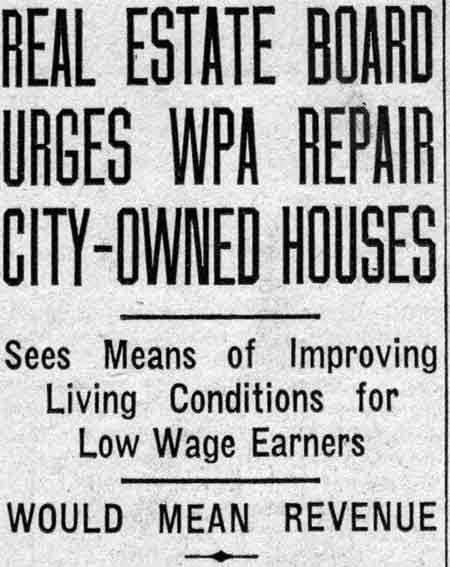
|
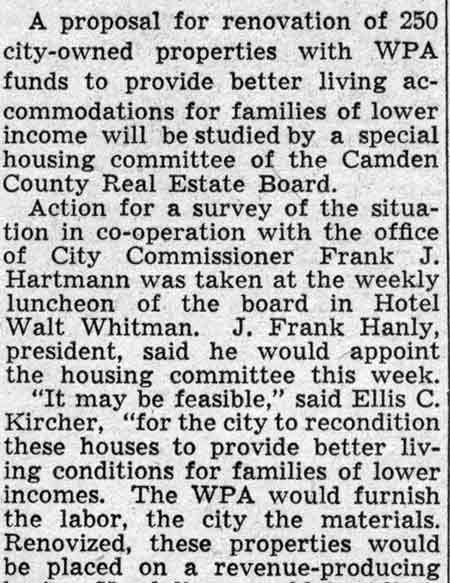
|
|
…continued… |
|
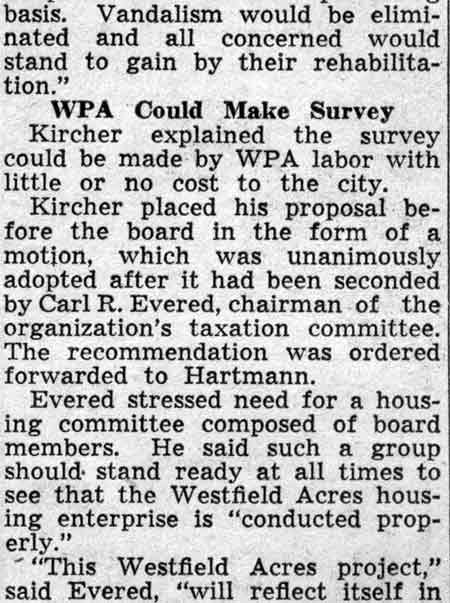
|
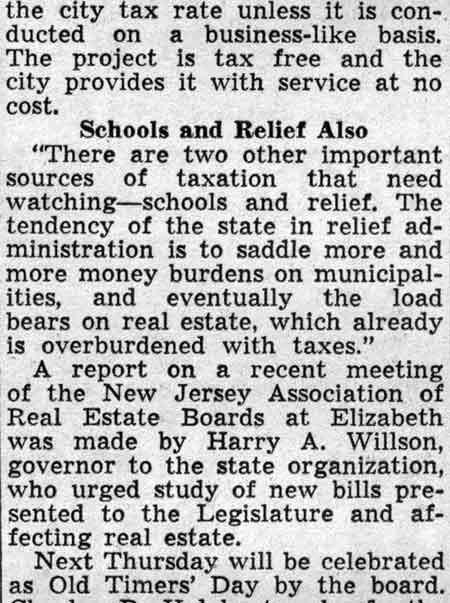
|
|
…continued… |
|
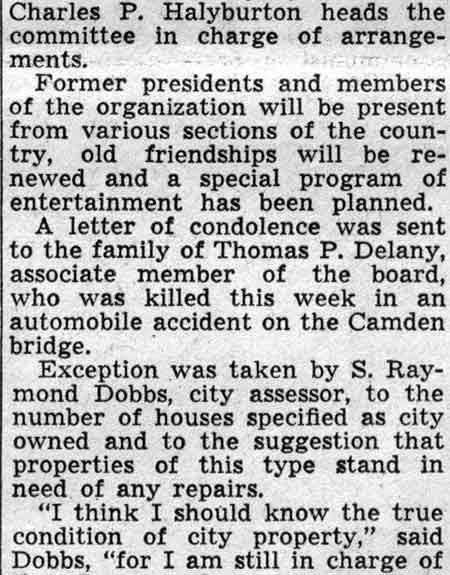
|
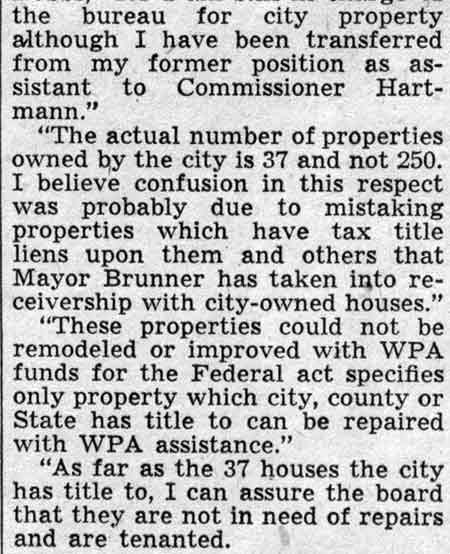
|
|
Frank
J. Hartmann Jr. - J. Frank Hanly
- Hotel
Walt Whitman - Ellis C. Kircher
- Carl
R. Evered |
|
|
WESTFIELD ACRES From the Booklet
The Site The first public housing development projected in Camden was planned, financed, and constructed by the federal Public Works Administration in the days before the local Housing Authority came into existence. It antedated the enactment of the United states Housing Law of 1937- the statute which sanctioned the new public policy of the nation to provide better living conditions for that one-third of the American people inadequately housed, clothed and fed according to American standards. The movements sponsored by civic groups and the municipal authorities to provide better housing for Camden found concrete expression when the Action Committee of 1935 persuaded the PWA to earmark $3,500,000 to finance a housing project. From 11 sites surveyed by the State Housing Authorities, a 26-acre plot sloping toward Westfield Avenue was chosen for the project. Twenty-five acres of it were a rolling sandy waste which had to be reclaimed. At the corner of Westfield Avenue and 32nd Street was an acre of cultivated land on which was an old house called the "Mansion". This was razed to make room for the "Acres" and the land on which it stood was bought for $6,000. The original plans called for a slum-clearance project in conjunction with new buildings, and a site in South Camden was selected. As the choice of that location would have involved the demolition of many homes, which the owners would not relinquish without the right of eminent domain, a prerogative which the Comptroller-General of the United States ruled the PWA did not possess, it was decided to build on the Westfield Acres tract instead. The land was purchased outright by the government. In the latter part of 1938, however, a test case which was reviewed by the New Jersey Supreme Court sitting en bane, Mr. Justice Bodine said "there is no more reason why the Legislature of our State may not, under its power of eminent domain, take private property to effect slum-clearances than that it may not take private property in order to provide for roads, railroads, and swamp clearances." He approved the housing program and found no barrier, Constitutional or statutory, to its continued operation. The tract is bounded on the south by Westfield Avenue, on the east by 32nd Street, on the west by the Camden-Burlington Railroad, and on the north by Pleasant Street, beyond which it extends for a short distance. It is easily accessible from the Market Street ferry by a five cent fare bus and from Philadelphia by bus for 15 cents.
The Plan Since May 1938 tenants have lived in Westfield acres, ground for which was broken on November 2, 1935. The development consists of 18 brick buildings of modern design, the plans for which were drawn by Associated Architects of Camden City. Three stories high, the structures are divided into 514 apartments of three, four, and five rooms each. Each of the 514 apartments is equipped with a tiled bathroom. The kitchens are covered with inlaid linoleum, and are supplied with electric cooking ranges and electric refrigeration. Group incinerators are provided to dispose of all refuse, and streets and street lighting are maintained by the project. Space has been reserved for community and recreational buildings and outdoor concerts. The grounds are beautifully landscaped and well cared for. A central heating plant supplies uniform and adequate heat at all times. Construction of these apartment dwellings cost $3,116,000. The Housing Authority on May 24, 1938 entered into an agreement with the Bendix Laundry Rental Service for furnishing metered washing machines for one year at a cost of 10 cents for every half-hour's use. 10 percent of the gross receipts to be paid to the Authority. Each f the ten laundries, located conveniently about the "Acres", has one machine installed and ready for use at any hour of the day. A spare machine is kept in reserve to replace any that may be disabled. Each laundry has ample space and drying racks for the air-drying of clothes. Management and Tenant Relations In order to reach the lowest income group, tenancy has been limited to families whose income does not exceed five times the rental value, with exceptions for families having three or more minor dependents, in which case the income may not exceed six times the rental value. In February 1941 tenants engaged in defense work whose income exceeded the permissible maximum were allowed to remain until additional housing facilities became available, but a surcharge of 25 cents was added to their monthly rent for every $15 of extra annual income. This was not a final solution. War and defense contracts in Camden plants have not only caused the increase of the population but have provided workers in certain fields abnormally high incomes. This has posed an important problem for the Housing Authority. Tenants whose incomes formerly fell within the limits are earning so much more now because of overtime work that their income exceeds the original limitations set by the Authority. In view of the housing shortage in Camden and the fact that incomes will revert to normal after the war, the Housing Authority felt impelled to adopt an arrangement that would avoid hardship and yet assure equitable treatment for all tenants. This was achieved by a revision of rent scales which take into consideration the increased wages if tenants who have been living in Westfield Acres and will permit adjustment of rents in the future when wages are not abnormal. Instead of the usual three rental schedules based on three average income levels, five basic schedules will be instituted in 1942. In addition, a system of surcharges has been adopted for those tenants whose incomes exceed the highest established grade. The income limits, for families of varying sizes, are as follows:
The rents and number of apartments available for each grade are as follows:
After admission, as incomes rise above Grade X, rents are increased. A surcharge of 25 cents a month is made for each $15 a year or fraction thereof by which a tenants income exceeds the limit for Grade X. A rental of $50 per month, however, has been established as the top. The lowest annual income for a Westfield Acres family is $454; the highest, $1,839; and the average, $1,308. The income restrictions had obliged 64 families to move from Westfield Acres prior to June 1, 1940. Only 25 of those families had been able to find homes in Camden; the balance was scattered outside the city. Between April and October 1940 apartments were vacated by 32 families who purchased their own homes. There never has been an eviction for misconduct or nonpayment of rent, delinquency losses have been in the proportion of only $1 for every $10,000 of rental. A family required to move elsewhere because o increased earnings is given a reasonable time in which to find a new home and everything possible is done to assist those who must depart. Problems of management have been few, Children have been careless at times at play in their homes and about the grounds. Parents are notified of mischievous acts and are expected to apply corrective measures and to pay for material or property damage. But such instances have been rare, and no case of juvenile delinquency has been recorded against the 600 children at the "Acres". At the rear of the "Acres" for the use of tenants is a baseball field, which is also used for outdoor community gatherings, and a large playground is available directly across Westfield Avenue at Dudley Grange Park, a city park of about 50 acres. Situated at convenient points in the "Acres" grounds are three community halls where classes are conducted in sewing, and lectures are given on child hygiene, cooking, and other subjects.
In the administration building is a well stocked library which is growing rapidly by reason of constant additions by the tenants. It now comprises more than 400 volumes. it is serviced by the National Youth Administration and is free to all tenants. The administrative personnel consists of a manager and an assistant manager, two typist-clerks, a bookkeeper, a building superintendent, a chief engineer, four engineers, eight janitors, a general maintenance mechanic, two maintenance helpers, and two gardeners. Before acquisition of the parcel by the government, the city's tax anticipation from Westfield Acres was $878.40. Westfield Acres pays the city $4,700 in lieu of taxes, or a net gain in revenue of $3,821.60. If privately owned, Camden's share of anticipation would be $41, 502.84, thus showing a theoretical loss of $36,802.84 A survey of the operating figures for a comparable area, however, deducting costs for services not supplied to Westfield Acres, reveals a gain of $7,455.84 to the city. In addition, the enormous benefits to the tenants that cannot be revealed by figures, must be kept in mind. |
||||||||||||||||||||||||||||||||||||||||||||||||||||||||||||||||||||||||||||||||||||||||||||||||
|
WESTFIELD ACRES |
|
|
The photographs shown below were taken by Mr. J. Richard Altieri, Liasion Construction Supervisor of the United States Housing Authority, on the occasion of his visit to this project on February 6, 1939. |
|
|
Showing typical type of main entrance doors leading to the apartments. |
|
|
Showing incinerator hoods installed by maintenance men. |
|
|
Showing play area converted into drying space. |
|
|
Showing main entrance door to apartments blown off during heavy windstorm. |
|
|
Looking at play area through wall - Building 15. |
|
|
Showing Social Room in Building 15. |
|
|
Showing mall at Building 9 where children are nor permitted to play. |
|
|
Showing laundry room which is greatly congested due to lack of laundry trays - Building 8. |
|
|
Showing pre-kindergarten class. |
|
|
Showing entrance to Boys' Club and Social Room - Building 9. |
|
|
Showing woodworking shop. |
|
|
Showing joiner in woodworking shop. |
|
|
Showing boiler room. |
|
|
Showing reinforcement at head of exterior door to prevent splitting of door by windstorm. |
|
|
Showing children at play in pre-kindergarten class. |
|
|
Showing
play area converted into drying area - |
|
|
Showing Library in Building 17. |
|
|
Showing Social Room in Building 17. |
|
|
Click on Image to Enlarge |
|
|
June 5, 1939 Manager Meyer Wessel submitted an series of reports. An interesting page among the reports assembled was on date June 5, 1939. It reports that since May 1, 1938, the date that the first family took up residence at the Acres, there were 38 babies born! There also were four deaths among Acres residents. Westfield Acres was segregated, as all Camden public housing was prior to the 1950s. The ethnic make-up of Westfield Acres families on June 5, 1939 was as follows:
|
|
Camden Courier-Post - June 15, 1939 |
|
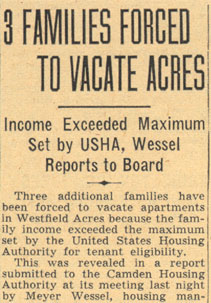
|
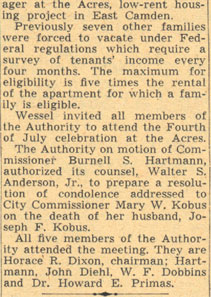
|
|
May 1940 |
|
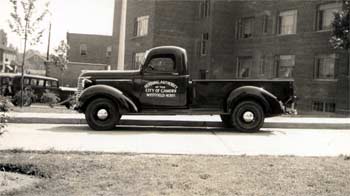
|

|
|
The Housing Authority acquired a new 1939 Chevrolet pickup truck in May 0f 1939. Having the truck enabled to maintenance staff to pick up trash far more efficiently. Soon after the acquisition of the truck, a garage was built by adding on to the Boiler House. Above are two pictures of the truck, parked on Beideman Avenue at Saunders Street. |
|
| Click on Images to Enlarge | |
|
Westfield Acres Christmas Decorations - December 1939 Elmer W. and Catherine Marzi moved to Apartment 22 in May of 1938. These pictures were taken of their Christmas decorations in 1939. |
|
MEMORIAL DAY 1941 |
|
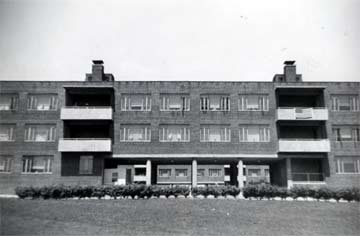
|
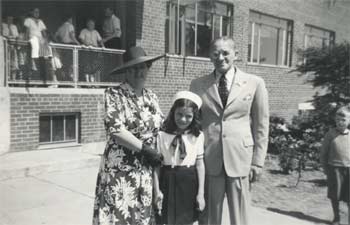
|
| Above:
The Acres, as viewed from Westfield Avenue. |
Mary
Ellen Soistmann, an "Acres" girl, & Meyer Wessel |
| Right:
Mrs. Dora Feldman, Apartment 29 Gold Star Mother Her son, First Lieutenant Jacob Feldman was killed under heroic circumstances. He was attached to Company D, 110th Infantry, 28th Infantry Division during World War I. He was mortally wounded on September 12, 1918, near Marancourt, France. |
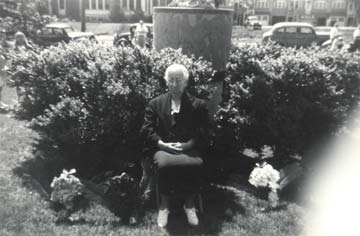
|
| Click on Images to Enlarge | |
|
JULY 4th, 1941 |
|||
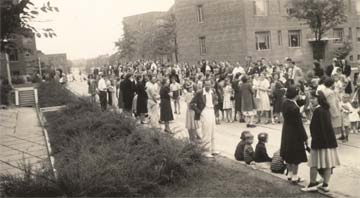
|
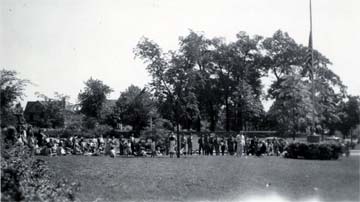
|
||
|
Above,
Left and right: Waiting for the parade to begin on Beideman Avenue. Below
Left: Baby Parade on Beideman Avenue; |
|||
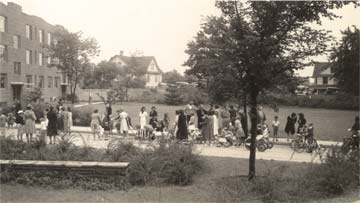
|
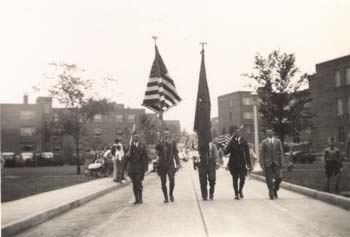
|
||
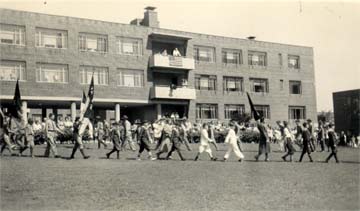
|
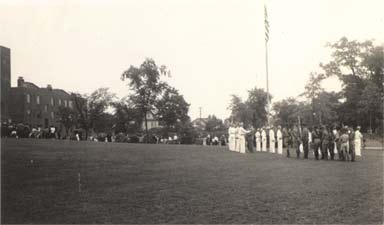
|
||
| Above
left: On parade in front of the acres, from Westfield Avenue & Dudley
Street Above right: Flag raising exercises, from Westfield Avenue & Dudley Street Below left: View of flagpole from Dudley Street,
Westfield Avenue in background. |
|||
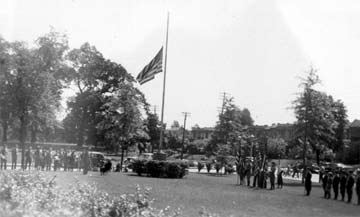
|
|
||
|
|||
| Above
Left: The Color Guard Above Right: Dignitaries for the day's events |
|||
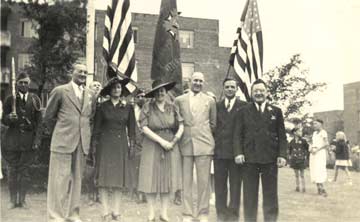
|
Participants
in the patriotic program. Front Row, from left to right: Meyer
Wessel, Westfield
Acres Manager |
||
| Below
Left: Patriotic Program as seen from across Westfield Avenue Below Right: Participants in Flag Raising exercises just before disbanding |
|||
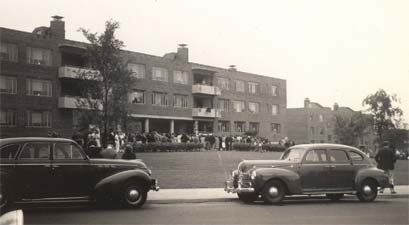
|
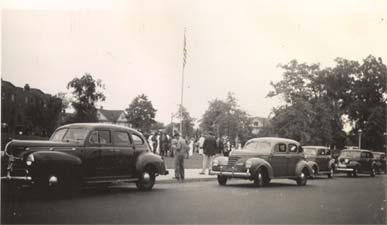
|
||
| Click on Images to Enlarge | |||
|
July 23, 1941 |

|
| Westfield Acres Boys Club - Charles Evans |
| July 1941 | ||
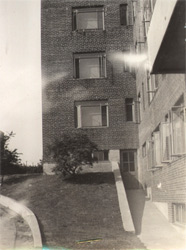
|
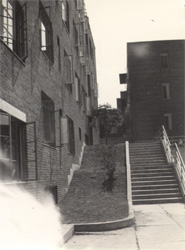
|
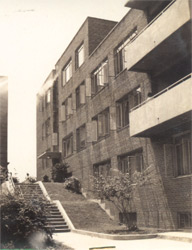
|
| Embankment in front of laundry entrance of Building 13 | Concrete steps and
terrace on Northeast side of Building 13 at higher level |
Concrete steps and terrace on Southeast side of dell |
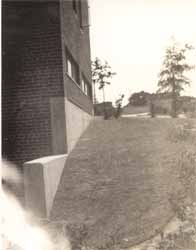
|
Left: North wing of
Building 9 near Boiler House, showing terrace which was badly rutted.
Erosion was an ongoing problem for groundskeepers at the Acres Right: Showing |
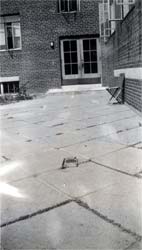
|
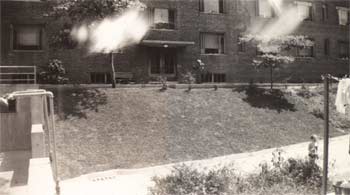

|
||
| Left:
Embankment between Buildings 14 and 8, immediately behind the children's sprinklers. Right: Concrete steps and terrace at Northeast corner of Building 13 |
||
|
Click
here to read the letter which accompanied these photographs, dated August 8, 1941 |
||
| Click on Images to Enlarge | ||
|
WESTFIELD ACRES The War Years - 1942-1945 After the article above was published, war production and the draft resulted in changes to the population of Camden and the tenant base at Westfield Acres. As war workers and the sons of tenants were inducted, changes to their family size and income levels resulted in conflicts with the income eligibility rules. Upper management responded in an honorable fashion, and servicemen's families were taken care of., under the direction of Mrs. Mary Ellen Soistmann, who for many years was the manager at Westfield Acres. The first manager was Meyer Wessel.
Sadly, more than a few men from the Acres did not return from the war. Westfield Acres war dead include the following:
|
|||||||||||||||||||||
|
WESTFIELD ACRES The Post-war Years The return to the pre-war rules regarding income limits, and the housing shortage in Camden County in the late 1940s caused hard feelings, and as the Housing Authority was a public agency, politics began to encroach on the Authority. Vigilant action by the Board of Commissioners, then chaired by Joseph McComb, kept problems that occurred at Branch and Chelton Terrace from occurring at Westfield Acres. After the war, Westfield Acres experienced some problems with its heating plant, which resulted in a conversion from coal to gas.
The families of many returning veterans set up housekeeping at the Acres, some taking advantage of the subsidized rentals while attending college on the GI Bill. Other Acres families included widows and senior citizens. Over the next two decades, recognition of the need for senior citizens housing resulted in Camden's erection of three high-rise apartment buildings dedicated for senior citizens. Camden's public housing and public schools had been segregated prior to the beginning of World War II. Westfield Acres and William S. Ablett Village, located at State Street and River Road, were white-only, while Clement T. Branch Village and Chelton Terrace, both located in South Camden were built for the city's black residents. Desegregation of public housing in Camden occurred in the early 1950s. |
||||||||||||||||||||||||||||
|
Christmas in the Acres |
|
I remember that the entire Acres community would bring their old X-mas trees to the playgrounbd and they would burn them all within the framework of the monkey bars. Something you don't see too often anymore!!! Gary Wright |
|
Christmas in the Acres |
|
My family lived in the Ares at 525 Beideman Avenue, 2nd floor apartment in the middle, forgot the number… but like yesterday, I have fond memories of the fun we kids use to have, never to be afraid of someone shooting you or attacking you off the playground. I had a girlfriend at 523 on the first floor apartment left side. I had a school mate who I still see at class reunions who lived at 521 on 2nd floor right had side. The kids I grew up with all lived in the Acres I can remember we use to play hide and seek in the basement of the building it was hugh and NO one person came screaming downstairs to say hey you little…zxsq/!!! go home where you belong. It was great fun. I went to Henry H. Davis School, Cramer Jr. High, and Woodrow Wilson High School.. The Acres was a part of all the kids I grew up with and went to school with. It was a tragedy that they torn down the buildings, I really wanted a BRICK from the Ares for memories sake.. and I couldn't find anyone to go there and get me one…how sad I was. The kids I grew up with in the Ares fought, don't get me wrong, but not like today… cause you fought today, and tomorrow you were friends. There were kids names like Bumps, Nubby, Hoff, Sleepy, and Ralph and Billy and Carol and Ruth…too We did things together, even if it was just sitting outside after dinner and talking or eating penny candy or cookies if we had a neighbor who would bake them for us, and we did, Mrs. Hoffman. she was wonderful, we all loved her. I am amazed at the kids today, who never had that kind of fun like us. Yeah we were gangs to speak, but we had fun, we all played together in the field in front of 525 Beideman Avenue. Tag, baseball, football, kick ball, dodge ball.. or we would walk of to the little grocery store just outside the acres housing and pool our money to buy penny candy and we all had some, mostly bubble gum to see who could make the biggest bubble. We also climbed the trees at the acres, mostly in the back.. It was a great remembrance for me, when we lived in the Acres, I had so many friends, and went to school with all of them, from 2nd grade to High School. The Brick still upsets me, but its the memory of the buildings and the good times, back then, that will happen no more, because of Gangs, Drug Dealers. Wow what a shame.. Hey WESTFIELD ACRES, THANKS FOR THE MEMORIES… I now live in California, and often talk of how we lived in the projects as they called them back then.. but believe me it was a great time, these kids today will never know. I was 6yrs to 9yrs old when I lived there. A time I will always cherish. I know I sound like a cheerleader for the Acres, but believe me it was a wonderful place to live at the time. Low income families trying to get buy, each family helping one another, I hardly see that today. Wow, sharing your meal with your neighbor and kids. Carol
(TOY) Malone |
| Camden Courier-Post - March 23, 1959 | |
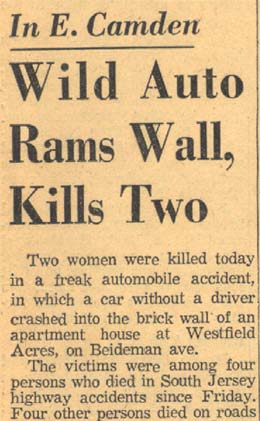
|

|
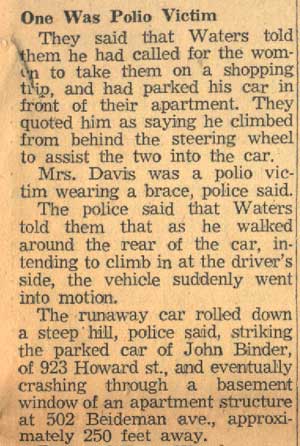
|
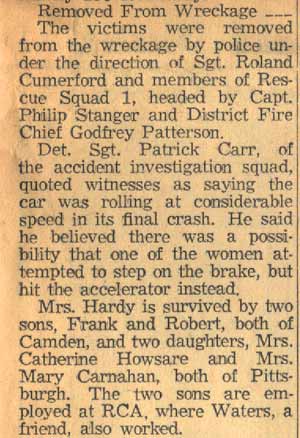
|

|
|
|
I lived in the third building from the front, third floor one bedroom (the front being where you paid the rent and Samples candy stand was). Bud Sample and his family were my cousins. The years I lived there, it wasn't a run down housing projects. I only remember one family name and it was Sinclair. From there we moved to Pennsauken, then to California Gail
Smith |
|
WESTFIELD ACRES The 1980s & 1990s The fate of Westfield Acres paralleled that of the rest of the City of Camden in the 1970s, 1980s, and 1990s. As the Acres was always intended as housing for the poor, the increased social problems that accompanied the urban poor in these years complicated the mission of management to keep Westfield Acres a decent place to live. The arrival of crack cocaine in Camden during the winter of 1985-1986 made a bad situation worse, and corruption and mismanagement at the Housing Authority of the City of Camden through August of 1999 made the situation virtually impossible. It also must be noted that the reluctance of judges at Camden's landlord tenant court to evict disruptive tenants did not make the situation easier… while a disruptive family may not have been made homeless, their actions also made decent life impossible for their neighbors, and this fact was (and still is) generally ignored by the judges of this court. While millions of dollars were poured into rehabilitation projects at the Acres in the 1980s and 1990s, many of these projects were poorly conceived and poorly executed.
While the buildings at Westfield Acres remained structurally sound, many had been literally taken over by drug dealers and criminals, and the management at the Housing Authority in the 1990s lacked the commitment, skills, and resources to address the problem. During this period the federal department of Housing and Urban Development stepped in and took over management of the Housing Authority from the local politicians who had served their community so badly. With the buildings falling into disrepair and control of the property rapidly eroding. a decision was made to raze the project and replace it. This process began in 1998. It was delayed, as the first two administrations put in place by HUD were little better ethically or competency-wise than the corruption-riddled one that they replaced. A federal grant was obtained for demolition and the relocation of the residents and demolition of Westfield Acres began in 1998. The 200 and 300 blocks of 32nd Street were also demolished as part of the new development.
In August of 1999, HUD stepped in again, and turned management of the Housing Authority of the City of Camden over to Dr. Maria Marquez. This marked a change, as Dr. Marquez was a Camden resident, and not politically tied to previous administrations or any other local political organization. Dr. Marquez was given 30 days to effect changes at the Authority, or it would be placed in receivership. She successfully instituted changes at the Agency, and and receivership was avoided. Demolition of Westfield Acres was completed in 2001. Under Dr. Marquez' leadership, a $35,000,000 grant was obtained to rebuild housing at Westfield Acres in 2000. Renamed Baldwin's Run, the new community, which will be a mixture of privately owned homes, market level rentals, and low-income housing, saw its first residents arrive in the spring of 2003.
|